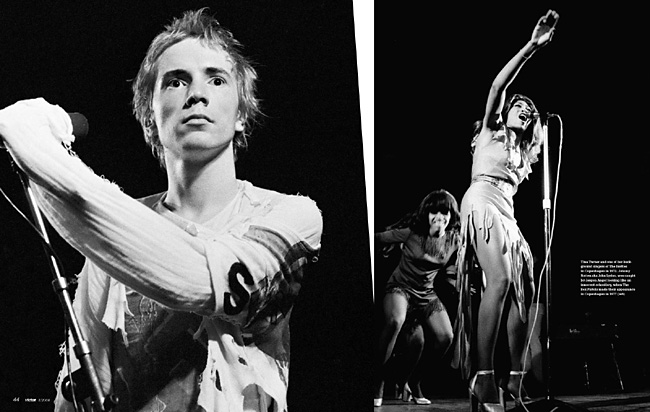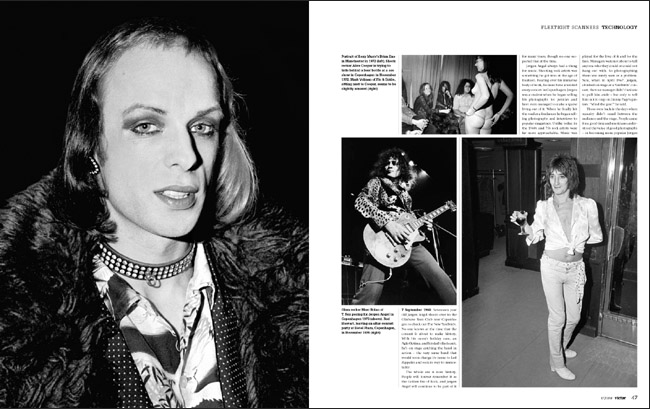
A magazine size 30x38 cm / 12x15 inch published by Hasselblad

Copenhagen photographer Jørgen Angel lived and captured a golden era in rock 'n' roll. Today he spends his time digitizing an expansive collection of gritty black & white images using Hasselblad's outstanding Flextight scanner.
The whole era is now history. People will forever remember it as the Golden Era of Rock, and Jørgen Angel will continue to be part of it for many years; though no-one suspected that at the time.
Jørgen Angel always had a thing for music. Shooting rock artists was something he got into at the age of fourteen. Pouring over his immense body of work, he must have attended every concert in Copenhagen. Jørgen was a student when he began selling his photographs for pennies and later even managed to make a sparse living
Those were back in the days when security didn't stand between the audience and the stage. People came for a good time and musicians understood the value of good photographs - in becoming more popular. Jørgen Angel was able to walk straight into dressing rooms and take pictures of musicians there. He would meet them at airports and party with them after concerts.

One scheduled session with Alice Cooper turned into a bash at a club somewhere in Copenhagen's red light district. Jørgen was simply dragged along. At first, the infamous shock rocker was shy about having his picture taken at a strip joint and tried to hide behind a curtain. But he couldn't see anything from there so he crept out and took cover, rather less effectively, behind a beer bottle.
When Jørgen looks back he remembers how friendly the rock celebreties used to be. Everyone always got along, and work was fun. The photographer was an accepted part of the crowd, never a burden. This enabled him to shoot portraits and pictures vibrant with energy and spontaneity - in a way that seems impossible today. By the early 80s, Jørgen Angel decided to put down his camera because managers had started to insert themselves between the stars and their followers. Photographers were only permitted to work during the first three songs of a gig, if at all. Private photo shoots had become next to impossible. Far too many were now delivering the exact same material. "I looked at my work and asked where the inspiration had gone," says Jørgen
Angel. "I began to wonder if I was still good enough. And if you're asking that kind of question, chances are you're probably not." Fortunately, photography was never Jørgen's sole source of income. He'll never wind up homeless. "Work should either be fun or pay good money, if neither, it's time to go!" the friendly Dane said to himself.
50,000 negatives were left uncared for in various basements and attics. Jørgen had long shifted his focus to other things, feeling like the last survivor of the Golden Era. And many years went by before he was finally prompted to dig through his countless crates. This was the beginning of a long process. In the past, his work mode had been to make a print, stash the negative and move on to better things. Early experiments in the darkroom then revealed that some of his negatives had deteriorated beyond repair. The cheap strips of film which Jørgen used to buy - sold by the meter - had probably already been scratched when fed through the camera. The moment the film was developed and printed he would simply roll it back into the container, instead of storing it properly in negative sheets. Leaky attics and murky basements then took care of the rest.

Early experiments with numerous scanners resulted in further frustration. "Scanning black & white negatives is hard enough as it is, and I was dealing with old Tri-X pushed to IS0 1600 and even 2400. This means a lot of contrast but also a lot of grain." The printouts Jørgen made in the lab were equally unrewarding and the work extremely time consuming. It took a London-based gallery owner to knock some sense into him: "Look mate, you live in the country that produces the best scanners in the world. It's there you should be looking!" And so Jørgen Angel got in touch with Imacon, which is now a part of Hasselblad, where a series of test scans were able to convince him at once: "By then I'd been through a whole bunch of scanners. None of them gave me the detail I was looking for. Many of my photos looked as
though they were taken under controlled conditions, when in fact, they were always spontaneous. Bringing this across calls for some pretty sophisticated equipment."
Today, Jørgen has scanned 2000 of his 50,000 photographs. Using a Flextight Precision 3, he spends hour upon hour removing the ugly traces of time. In the long run he wants to digitize and preserve his complete collection. "Some pictures require two to three hours of touching up, removing dust, scratches and stains," he explains. Jørgen swears by the quality of the Flextight: "The portrait of Robert Plant in March 69, one of my favorite shots, was taken with my mom's snapshot camera. The fact that it can be printed as large as DIN A0 format - that's the size of a door! - is solely thanks to the Flextight scanner."

Time is a serious consideration when you're faced with tens of thousands of images, all requiring digitzation to the highest quality standard. Fortunately, Jørgen Angel is about to cut back on involuntary coffee breaks by switching to the Flextight X5. Then he'll be scanning at approximately 2 minutes per 35mm negative - obviously at the maximum quality setting. He'll be batch processing and using an effective condenser lens to suppress smaller scratches and dust particles reducing retouching dramatically. High speed scanning is not only much easier, but also ensures an effective way to safely store prints or negatives, before they get attacked by mold, fade or are irretrievably destroyed by other factors.
Even though Jørgen makes use of digital technology for much of his work - whether the Flextight scanner, digital camera or inkjet printer - the classic rock fan has fond memories of the analog era. If someone orders a handmade print from his website (www.angel.dk) and he has to work with an original negative, he heads for the darkroom with mixed feelings. "I hate having to go in there. But once I actually get going with the old equipment I feel totally in my element. I'm still fascinated when I watch the picture develop in the tray." His scans, too, are printed on original photo paper as quality and authenticity are of great importance to the photographer.
"The Flextight scanner has changed the way I work," he says "finally I have the right equipment." This wasn't always the case. Several years passed before his mother's holiday camera was replaced by a Rolleiflex, a camera he still owns and which is just as old as he is. Later he used Nikon and even Hasselblad, but he ended up selling most of his gear when he dropped out of the scene. He parted with various relics of the old days, even his large vinyl record collection - his wife never really understood rock 'n' roll. In his apartment you'll only find a single photo, the vibrant depiction of Freddy Mercury on page 42. This is all that hints at his old profession.
Those who speak with Jørgen Angel, visit his exhibition or browse his website will appreciate the short anecdotes beside certain pictures. Now we know that glam rock star Marc Bolan was one of the friendliest of all but also vain enough to appreciate a good picture. The photo on page 47 shows him live in concert, but, having spotted Jørgen Angel standing in front of the stage, Mr. Bolan was also sure to take the time to pose for him. What we see in Jørgen's work is rocking stage energy at its crudest and best. Some shots also give the viewer a glimpse behind the scenes. Take the picture of Sex Pistols idol Johnny Rotten, who looks like a harmless school boy on page 44 unquestionably the exact opposite of what he was trying to be at the time.
"Thanks for Being There!"
Perhaps to a certain degree it was the very nature of these shots, so alive and real, that lead to the demise of Angel's work: they became marketing tools that image-obsessed managers soon wanted to control. Concurrently, the competition was growing: "After the 1967 film Blow-Up, starring David Hemmings as the slick photographer, everyone wanted to be a photographer," says Jørgen Angel. So what was it like being part of the Golden Era? "Back then, I didn't know I was part of an historic moment, no one imagined that it wouldn't last forever. I loved the music, had fun and really enjoyed working. I was a school boy who didn't give two thoughts about whether someone who was famous at the time would also be famous a year later, not to mention in 40 years time." Well, thank God it never stopped him from taking pictures. Jimmy Page probably puts it best, in a comment on the photographs of the first Led Zeppelin concert: "Jørgen, thanks for being there!"
By Hanns W. Friedrich
For further information on the Imacon/Hasselblad scanners please visit www.hasselblad.com/products.aspx
To go to the other interviews clik here: INTERVIEWS
To go to the Jørgen Angel Photography main page clik here: MAIN PAGE